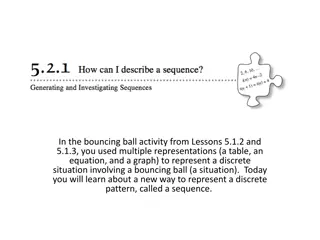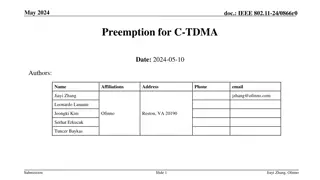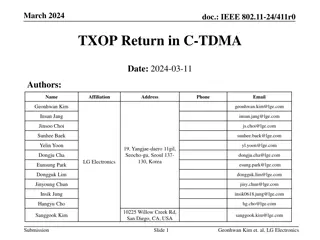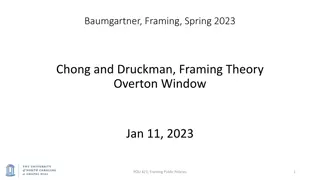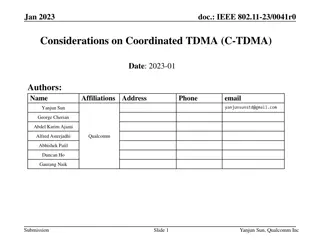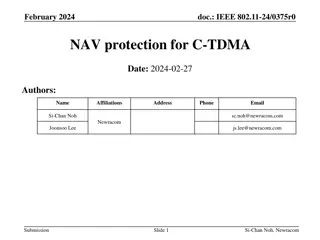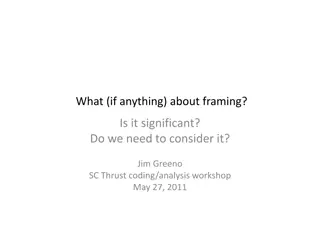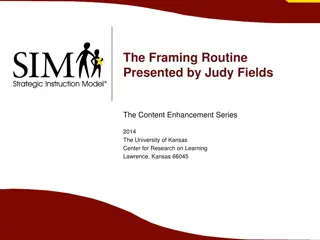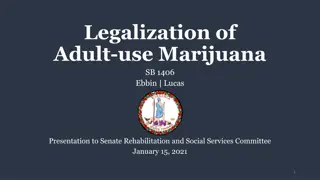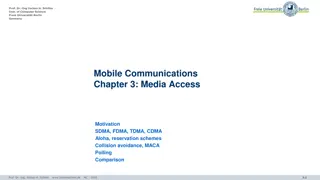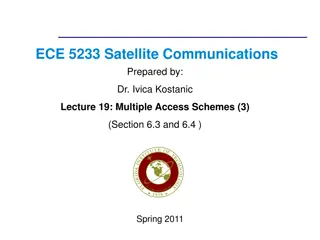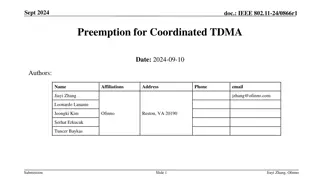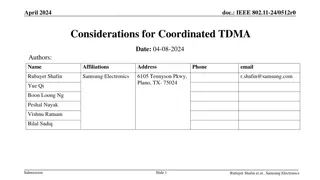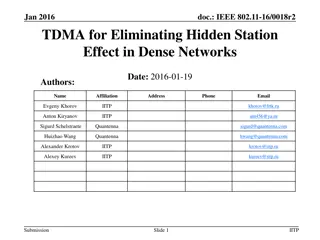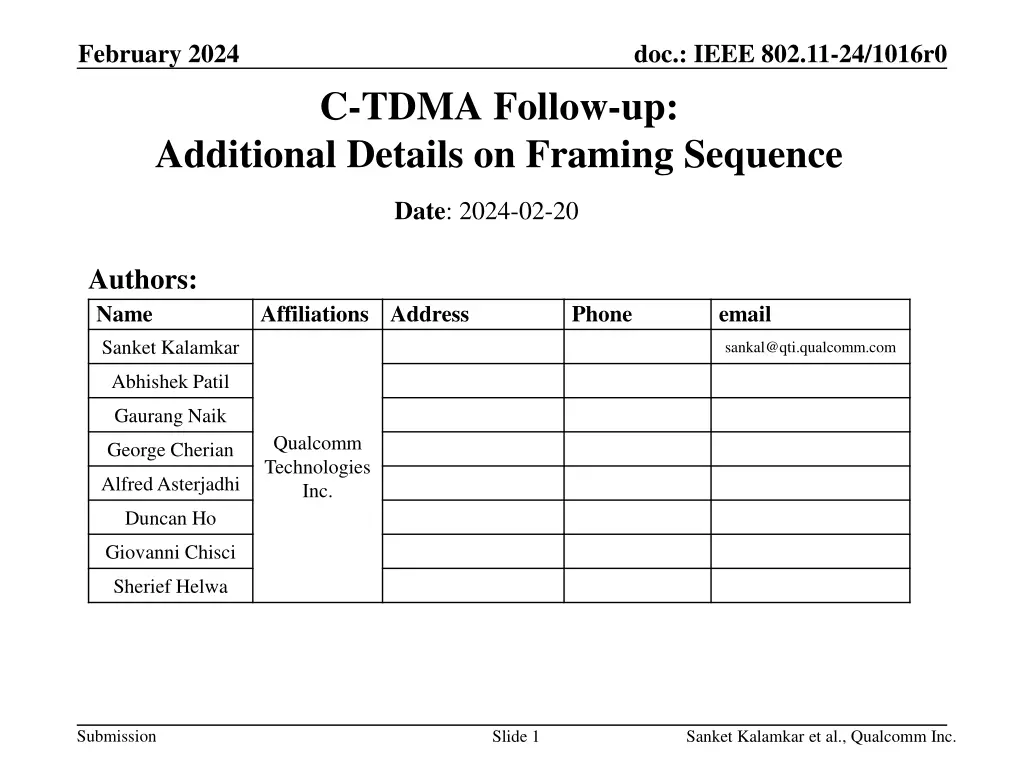
IEEE 802.11-24/1016r0 C-TDMA Framing Sequence Details
Explore detailed information on the framing sequence for IEEE 802.11-24/1016r0 C-TDMA protocol, including polling, announcement frames, AP interactions, and the need for polling/announcement frames to optimize TXOP sharing efficiency.
Download Presentation

Please find below an Image/Link to download the presentation.
The content on the website is provided AS IS for your information and personal use only. It may not be sold, licensed, or shared on other websites without obtaining consent from the author. If you encounter any issues during the download, it is possible that the publisher has removed the file from their server.
You are allowed to download the files provided on this website for personal or commercial use, subject to the condition that they are used lawfully. All files are the property of their respective owners.
The content on the website is provided AS IS for your information and personal use only. It may not be sold, licensed, or shared on other websites without obtaining consent from the author.
E N D
Presentation Transcript
February 2024 doc.: IEEE 802.11-24/1016r0 C-TDMA Follow-up: Additional Details on Framing Sequence Date: 2024-02-20 Authors: Name Sanket Kalamkar Affiliations Address Phone email sankal@qti.qualcomm.com Abhishek Patil Gaurang Naik Qualcomm Technologies Inc. George Cherian Alfred Asterjadhi Duncan Ho Giovanni Chisci Sherief Helwa Submission Slide 1 Sanket Kalamkar et al., Qualcomm Inc.
February 2024 doc.: IEEE 802.11-24/1016r0 C-TDMA Frame Exchange Sequence Previous contributions discussed the following framing sequence [1, 2, 4, 9-11, 13]: The sharing AP polls candidate shared APs via Poll/Ann. frame The sharing AP triggers TXOP sharing via TXOP Allocation frame The shared AP returns unused TXOP (if any) via TXOP Return frame This contribution provides next-level details for the Poll/Ann. frame Polling/ TXOP Allocation (MU-RTS TXS) AP1 Announcement Frame Exchange(s) between AP1 and its STA(s) (Sharing AP) Time Resp* STAs of AP1 AP2 Resp Not interested in C-TDMA in this TXOP (Shared AP) Return the TXOP back to AP1 Time TXOP Return AP3 Resp Frame Exchange(s) between AP3 and its STA(s) CTS (Shared AP) Time *Polling of in-BSS STAs of the sharing AP is optional Submission Slide 2 Sanket Kalamkar et al., Qualcomm Inc.
February 2024 doc.: IEEE 802.11-24/1016r0 Details of Polling/Announcement Frame Sharing AP sends Poll/Ann. frame at the start of the TXOP to: Announce its intent to share a part of its TXOP Poll candidate AP(s) to check their interest in participation Optionally, poll its in-BSS STA(s) The Poll/Ann. frame may specify traffic priority for the shared TXOP, e.g.,: AC, SCSID, TID of the traffic A response from a polled AP may indicate: Its intent to participate in C-TDMA Relevant information about its traffic The Poll/Ann. frame helps shared AP(s) make scheduling decisions: whether to participate in sharing during the current TXOP A shared AP will not participate if it has no traffic for the indicated traffic type If participating, the AP identifies suitable client(s) to serve during the shared TXOP Submission Slide 3 Sanket Kalamkar et al., Qualcomm Inc.
February 2024 doc.: IEEE 802.11-24/1016r0 Need for Polling/Announcement Frame An AP can have an agreement with multiple APs in its neighborhood to perform TXOP sharing (i.e., participate in C-TDMA) Two participating APs might have knowledge of each other s long-term traffic profiles, e.g., SCS agreements Having knowledge of long-term traffic needs of an AP is not an indicator of its resource needs AP during the sharing AP s TXOP Actual traffic arrival fluctuates around the expected traffic arrival due to jitter and other factors (see figure below) TXOP won by AP1 Time wasted TXOP Allocation (MU-RTS TXS) Frame Exchange(s) between AP1 and its STA(s) AP1 Return the TXOP back to AP1 Time (Sharing AP) TXOP Return AP2 Traffic (Shared AP) CTS Expected arrival of traffic Actual arrival of traffic Time Jitter Submission Slide 4 Sanket Kalamkar et al., Qualcomm Inc.
February 2024 doc.: IEEE 802.11-24/1016r0 Need for Polling/Announcement Frame (contd..) TXOP sharing without a Poll/Ann. frame at the start of the TXOP : Time Wasted TXOP Allocation (MU-RTS TXS) TXOP Allocation (MU-RTS TXS) TXOP Allocation (MU-RTS TXS) AP1 ICF Frame Exchange(s) between AP1 and its STA(s) (Sharing AP) STAs of AP1 Time ICR Return the TXOP back to AP1 AP2 TXOP Return CTS (Shared AP) Not interested in C-TDMA in this TXOP Time Return the TXOP back to AP1 TXOP Return AP3 CTS (Shared AP) Time Return the TXOP back to AP1 TXOP Return Frame Exchange(s) between AP4 and its STA(s) AP4 CTS (Shared AP) Time TXOP sharing with a Poll/Ann. frame at the start of the TXOP: TXOP Allocation (MU-RTS TXS) AP1 Poll/Ann. Frame Exchange(s) between AP1 and its STA(s) (Sharing AP) STAs of AP1 Resp /ICR Time AP2 Resp (Shared AP) Not interested in C-TDMA in this TXOP Time Resp AP3 (Shared AP) Return the TXOP back to AP1 Time TXOP Return Frame Exchange(s) between AP4 and its STA(s) Resp CTS AP4 Time (Shared AP) Submission Slide 5 Sanket Kalamkar et al., Qualcomm Inc.
February 2024 doc.: IEEE 802.11-24/1016r0 Need for Polling/Announcement Frame (contd..) Furthermore, a candidate shared AP may be unavailable during the TXOP E.g., due to OBSS NAV, Co-Ex, AP power save, etc. Possible that the traffic buffered at a candidate AP does not meet the traffic priority for the shared TXOP determined by the sharing AP And hence can t use the shared portion of the TXOP When an AP obtains a TXOP, how does it decide whether to share this TXOP and, if so, with whom? An AP doesn t have to share every TXOP that it obtains And, if it decides to share a TXOP, it should share the TXOP with the neediest AP Blind TXOP sharing will lead to unnecessary overheads and poor performance TGbn must provide a mechanism for sharing AP to: announce its intention to share the TXOP poll the candidate APs Submission Slide 6 Sanket Kalamkar et al., Qualcomm Inc.
February 2024 doc.: IEEE 802.11-24/1016r0 Additional Considerations Some existing features require an ICF/ICR exchange at the start of a TXOP E.g., eMLSR Some TGbn features propose to have ICF/ICR exchange at the start of a TXOP E.g., Co-Ex, AP PS, etc. The poll-response mechanism for C-TDMA fits this design Poll/response is yet another ICF/ICR Can be combined with an ICF/ICR exchange meant for another TGbn feature Such approach will improve the overall efficiency of the protocol The BSRP Trigger frame can be considered as Poll/Announcement frame The poll can include candidate shared APs and optionally one or more its associated STAs Each responder is assigned a distinct resource unit (RU) Allowing the sharing AP to unambiguously identify who responded and who did not Based on the responses, the sharing AP can decide its TXOP sharing plan Note: Other forms of ICF for polling at the start of the TXOP can be considered. Submission Slide 7 Sanket Kalamkar et al., Qualcomm Inc.
February 2024 doc.: IEEE 802.11-24/1016r0 Response to the Polling/Ann. Frame Polled shared AP(s) provide a response such as interest vs disinterest Interest: Nonzero values as the response indicate acceptance Exact format of the response is TBD BSR Control could be modified/extended for this purpose Alternatively, TGbn could define a new frame / A-Control Disinterest: All 0s in all BSR Control fields indicates that the polled AP is not interested in utilizing portion of the TXOP E.g., when the polled AP does not have any buffers for the indicated AC in the polling frame from the sharing AP Submission Slide 8 Sanket Kalamkar et al., Qualcomm Inc.
February 2024 doc.: IEEE 802.11-24/1016r0 Summary To have efficient C-TDMA operation, the Polling/Announcement frame at the start of the TXOP is necessary Such a polling/announcement offers benefits over blind TXOP sharing and the TXOP sharing based on only long-term agreements Yet another ICF/ICR Improved efficiency of C-TDMA procedure The BSRP Trigger can be used for polling/announcement This framework allows a sharing AP to efficiently poll candidate shared APs Responses from polled APs help the sharing AP make informed decision about TXOP sharing Submission Slide 9 Sanket Kalamkar et al., Qualcomm Inc.
February 2024 doc.: IEEE 802.11-24/1016r0 SP1 Do you agree that a TXOP owner AP announces its intention of sharing a portion of the time resource of its TXOP for C-TDMA operation, in an Initial Control frame (exact ICF and name TBD) sent at the beginning of the TXOP and that the frame polls AP(s) with whom it may share the TXOP to determine their interest? A TXOP owner AP that intends to share its TXOP is referred to as a sharing AP. A candidate AP identified (polled) in the Initial Control frame is referred to as a polled AP. The Duration field of the frame is set to the length of time required to transmit the solicited response frame plus one SIFS. Whether or not the sharing AP is mandated to send the Initial Control frame that announces that intention is TBD. Submission Slide 10 Sanket Kalamkar et al., Qualcomm Inc.
February 2024 doc.: IEEE 802.11-24/1016r0 SP2 Do you agree that, as part of the C-TDMA procedure, a sharing AP shall send a TXOP Allocation frame (exact name TBD) to a single polled AP to share a time portion of its TXOP and the frame is an MU-RTS TXS Trigger frame? The duration of the shared TXOP shall be indicated in the Allocation Duration field of the frame. The Duration field of the frame is set to the length of time required to transmit the solicited response frame plus one SIFS. Submission Slide 11 Sanket Kalamkar et al., Qualcomm Inc.
February 2024 doc.: IEEE 802.11-24/1016r0 SP3 Do you support that a sharing AP identifies a shared AP via the AID12 field carried in the User Info field of the sharing AP s Trigger frame? Submission Slide 12 Sanket Kalamkar et al., Qualcomm Inc.
February 2024 doc.: IEEE 802.11-24/1016r0 References [1] Abhishek Patil and et al. , C-TDMA Frame Sequence, 23/1895r1, Jan 2024. [2] Yanjun Sun and et al., Considerations on Coordinated TDMA (C-TDMA), 23/0041r0, Jan 2023. [3] Dibakar Das and et al. , C-TDMA procedure in UHR, 23/0261r0, Apr 2023. [4] Yanjun Sun and et al., Follow-up on Coordinated TDMA (C-TDMA), 23/0739r1, Jul 2023. [5] Si-Chan Noh and et al., Considerations on Return TXOP between multiple APs, 23/1327r0, Aug 2023. [6] Liwen Chu and etc al., Extended TXOP sharing, 23/249r1, May 2023. [7] George Cherian and et al., Coordinated AP Time/Frequency Sharing in a Transmit Opportunity in 11be, 19/1582r2, Nov 2019. [8] Dibakar Das and et al., C-TDMA Follow-up, 23/93r2, Mar. 2024. [9] Geonhwan Kim and et al., TXOP Protection in C-TDMA, 24/227r1, Apr. 2024. [10] Geonhwan Kim and et al., TXOP Return in C-TDMA, 24/411r0, Apr. 2024. [11] Geonhwan Kim and et al., Coordinated TDMA (Follow up), 23/1910r1, Nov. 2023. [12] Si-Chan Noh and et al., NAV protection for C-TDMA, 24/375r0, Feb. 2024. [13] Sanket Kalamkar and et al., NAV Rule in C-TDMA, 24/423r0, May 2024. Slide 13 Submission Sanket Kalamkar et al., Qualcomm Inc.




